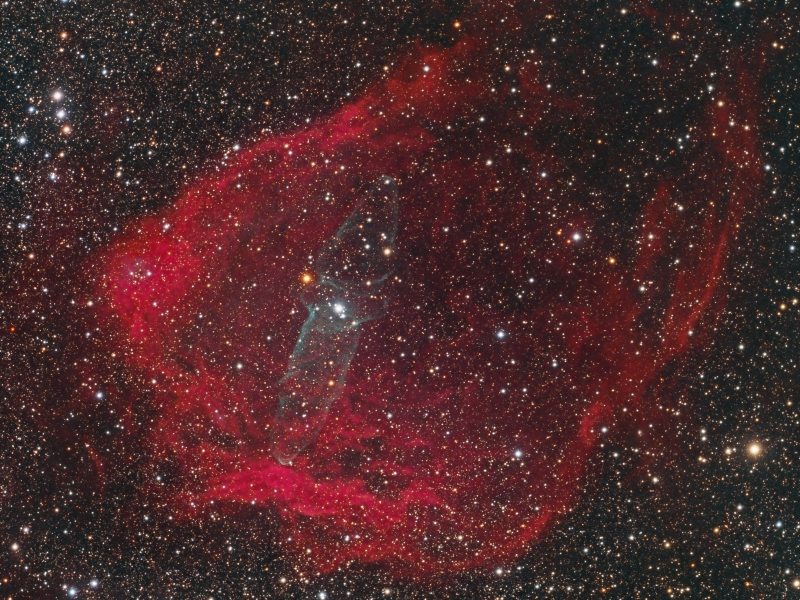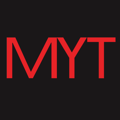
Larger size jpg image available here: 1920x1440
The Flying Bat (Sh2-129) and the Squid nebula (Ou4)
About this object
This image of the Flying Bat nebula and the squid nebula was undoubtedly the hardest image I’ve tried to process. This image was taken in three steps, at home, the Okie Tex Star Party in Kenton OK in Sep and my friends home in Ky using two scopes. I started taking a few Ha exposures at home before I left for the Okie Tex star party using the Stellarvue SV70 and continued imaging using the SV70 at Okie Tex. My friend Dean Schwartzenburg also imaged this object and provide me a bunch of Ha and OIII exposures with his Tak FS60 and all were combined into this composite image using PixInsight. The squid nebula, Ou 4, is really faint and is shown here at its relative brightness. It looks like a ghostly blue green transparent aberration. It was only recently discovered in 2011 by French astro imager Nicholas Outters and has a elongated bipolar shape. It’s virtually invisible in normal RGB or Ha exposures and only faintly visible using a OIII filter. This image combines 5.3hrs of RGB exposures, 11.6 hrs of Ha and 30hrs of OIII exposures.
Processing: This image was processed with PixInsight.
The subframes were reduced and registered and cosmetically corrected using the Batch preprocessing script of PixInsight.
The master Red, Green, Blue, Ha and OIII images were created using the PixInsight version of drizzle.
The masters were gradient corrected using dynamic background extraction
The corrected master Red, Green and Blue images were combined into a RGB color image
The color RGB image was color calibrated using the Photometric Color Calibration tool and the background neutralization tool was used to color correct the background
The RGB image was combined with the Ha and OIII masters using the NBRGB combination script using the default settings
The resulting HaOIIIRGB image was stretched using the histogram tool and the ADCNR noise reduction tool was used with masks protecting the high signal areas. The resulting imagenblack point was adjusted after noise reduction.
Local Histogram equalization was used in several iterations with a mask protecting the background and stars to increase the contrast of the high signal areas.
Morphological transformation was used with a star mask to reduce the intensity of the stars. Curves were then used with the star mask to slightly increase the star color saturation.
Several iterations of curves were applied enhance the nebula
The background enhancement script was then used on the image to enhance the background and nebula along with several more iteration of ACDNR noise reduction using range masks to protect the higher signal to noise areas.
This image of the Flying Bat nebula and the squid nebula was undoubtedly the hardest image I’ve tried to process. This image was taken in three steps, at home, the Okie Tex Star Party in Kenton OK in Sep and my friends home in Ky using two scopes. I started taking a few Ha exposures at home before I left for the Okie Tex star party using the Stellarvue SV70 and continued imaging using the SV70 at Okie Tex. My friend Dean Schwartzenburg also imaged this object and provide me a bunch of Ha and OIII exposures with his Tak FS60 and all were combined into this composite image using PixInsight. The squid nebula, Ou 4, is really faint and is shown here at its relative brightness. It looks like a ghostly blue green transparent aberration. It was only recently discovered in 2011 by French astro imager Nicholas Outters and has a elongated bipolar shape. It’s virtually invisible in normal RGB or Ha exposures and only faintly visible using a OIII filter. This image combines 5.3hrs of RGB exposures, 11.6 hrs of Ha and 30hrs of OIII exposures.
Processing: This image was processed with PixInsight.
The subframes were reduced and registered and cosmetically corrected using the Batch preprocessing script of PixInsight.
The master Red, Green, Blue, Ha and OIII images were created using the PixInsight version of drizzle.
The masters were gradient corrected using dynamic background extraction
The corrected master Red, Green and Blue images were combined into a RGB color image
The color RGB image was color calibrated using the Photometric Color Calibration tool and the background neutralization tool was used to color correct the background
The RGB image was combined with the Ha and OIII masters using the NBRGB combination script using the default settings
The resulting HaOIIIRGB image was stretched using the histogram tool and the ADCNR noise reduction tool was used with masks protecting the high signal areas. The resulting imagenblack point was adjusted after noise reduction.
Local Histogram equalization was used in several iterations with a mask protecting the background and stars to increase the contrast of the high signal areas.
Morphological transformation was used with a star mask to reduce the intensity of the stars. Curves were then used with the star mask to slightly increase the star color saturation.
Several iterations of curves were applied enhance the nebula
The background enhancement script was then used on the image to enhance the background and nebula along with several more iteration of ACDNR noise reduction using range masks to protect the higher signal to noise areas.
Image Details
- Optics : Stellarvue SV 70T triplet refractor and Tak FS60
- Mount: Paramount MYT and Astrophysics AP 900
- Camera: QSI 583 and QSI 640
- Filters: Astrodon e-series RGB,5nm Ha, and 3nm OIII
- Exposure(min): RGBHaOIII 110:100:110:700:1810 Total exposure time 47hrs
- Camera/Mount Control: The Sky X, CCD Auto Pilot 5
- Guiding: MyT, Unguided using ProTrack
- Processing: PixInsight 1.85
- Location: Stark Bayou Observatory, Ocean Springs, MS, Okie Tex Star Party Kenton OK, Doghouse observatory Nicholasville, Ky.
- Date: Sep/Oct 2017




